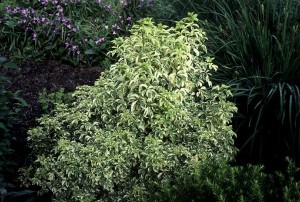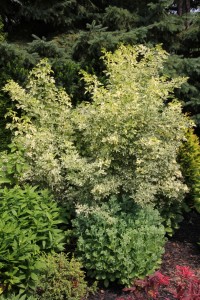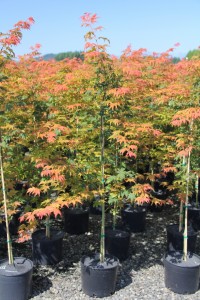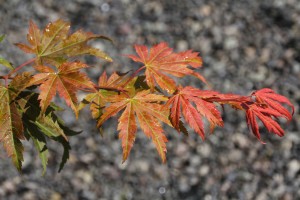I thought today’s post would feature two awesome plants that are relatively new or unheard of in the industry. Both of these plants have performed well in my own garden and survived our two hardest winters recorded since the 1970’s. Many plants suffered severe winterburn or even death due to extremely low temperatures, but not these two plants. They may be harder to find in the nursery/garden center, but are well worth it and have huge ornamental impact all growing season.

The first is variegated fiveleaf aralia, Eleutherococcus sieboldianus ‘Variegatus’ (formerly Acanthopanax sieboldianus ‘Variegatus’). I know, a really horrible, long scientific name for such a great plant. Now before I go on about this particular cultivar, I need to let everyone know that this is the cultivar you want, NOT the species that has all green leaves. The straight species is weedy, grows too large for most landscapes and is not colorful. The variegated cultivar is a real showstopper! It is low maintenance, grows slowly and rarely needs pruning. This medium-sized shrub grows about 5-6’ tall and wide in the northern U.S. growing larger in the south. The natural form is upright, rounded with long, arching branches. Suckering at the base of the shrub is slow, hence the plant does not become a nuisance in the garden. Variegated fiveleaf aralia is adaptable to most soils and pH, tolerates sandy and poor, dry, clay-based soils, will stay variegated in shade and will not scorch in full sun. It is quite drought tolerant with no pest problems. Deer and rabbits seem to leave it alone.

The foliage is quite clean with 5-7, bright, cream to yellow variegated leaflets with an emerald green center. There is no fall color to talk about, however, the brightly colored leaves mix well with other yellow, white or purple flowering/foliaged plants. The stems do have 1-2 curved prickles on them at a node, but they are short. Unlike its straight species, ‘Variegatus’ rarely flowers or fruits so the plant does not become invasive.
This plant is native to Japan and was highly promoted as an outstanding urban tolerant plant by my former graduate advisor, the late Dr. J.C. Raulston of North Carolina State University. He tested and evaluated thousands of landscape plants for adaptability to the southeastern U.S. and a few of those plants are actually hardy up in zone 4b.
Another great plant that I am more and more impressed with each day is a relatively new release from Iseli Nursery, Boring, Oregon. It is NORTH WIND® maple (Acer ‘IsINW’). This smaller, 15-20’ tall, ornamental maple is part of Iseli’s Jack Frost® series of hardy, ornamental maples. Through testing across the country, this maple has proven hardy to zone 4a without any dieback, unlike Japanese maple (Acer palmatum). One of the parents of this great hybrid is the Korean maple (Acer pseudosieboldianum), which is also zone 4 hardy.

The beauty of NORTH WIND® maple is that it combines the cold hardiness of Korean maple with the outstanding leaf qualities and deeper leaf lobes of the Japanese maple, one of the suspected parents, but with one exception. NORTH WIND® maple new leaves are bright orange! The color of these leaves lasts longer in the growing season in cooler climates. I have a young tree in my yard and the leaves are still orange, even this late into August. The older leaves gradually fade to green in midsummer. The orange-red fall color is superb and makes a real eyestopper in the autumn landscape. For best color, plant the tree in full sun to partial shade.

NORTH WIND® maple is pH adaptable and grows best in a moist, well-drained soil. I do not know yet how heat or drought tolerant this species is, but if anyone is growing this plant in southern climates, please let me know how it is doing.
Laura Jull, Ph.D. aka The Lorax
have grown Eleutherococcus sieboldianus ‘Variegatus’ for a number of years in PS to full shade and it does great. I now need to move it, and found cuttings taken in June root easily, as does layering. It does have some thorns.
How much sun did the one in the top top picture get? I think it has more white in the leaves than mine.
Partial shade only and it is still quite variegated. I think the full sun in early spring to May allowed the leaves to develop the variagation, followed by only morning sun.